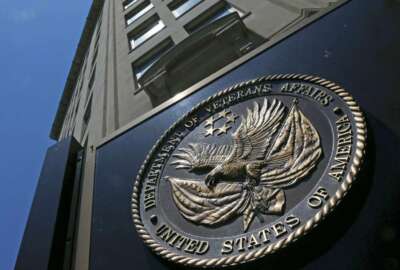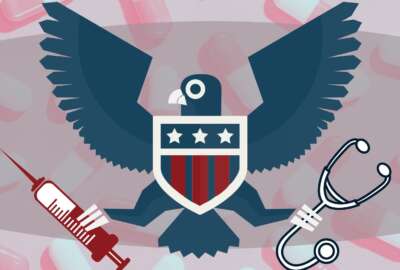VA seeks higher IT employee satisfaction as it modernizes veteran service delivery
The Department of Veterans Affairs, as part of a broader plan to improve service delivery for veterans, is looking to improve the experience of its IT workforce.
The Department of Veterans Affairs, as part of a broader plan to improve service delivery for veterans, is looking to improve the experience of its IT workforce.
The VA is working with its IT workforce to map out longer-term career advancement opportunities, and is rolling out tools to anticipate when employees are dealing with sluggish computers and other workplace frustrations.
The VA also is rolling out more automation tools meant to help claims processors keep up with a record volume of benefits claims. The department expects to release more automation tools this summer.
VA Secretary Denis McDonough and senior IT leadership said Thursday that the department is accelerating the pace of its modernization efforts to keep up with the demand for VA health care and benefits — and that these upgrades will improve the experience of employees and veterans.
“The right technology can do a lot for vets, and it’s having a real impact right now in the lives of vets across America,” McDonough said at the VA’s Tech Expo in Palo Alto, California.
McDonough said the COVID-19 pandemic “jumpstarted innovation and changed the way we do business,” and that VA will keep accelerating its pace of modernization to meet demand under the PACT Act.
The PACT Act, signed into law last August, expands VA care and benefits for veterans exposed to toxic burn pits during their military service. McDonough said IT modernization at VA is essential to driving down wait times and improving veterans’ trust in its services.
“That historic growth will require us to speed up claims processing to provide more timely access, accessible care, and enhance the experience for vets were already serving. And as we welcome those we’ve never served before, and those who are giving VA a second chance to get it right for them, we simply have to perform better,” McDonough said.
The VA, in its latest wave of latest IT modernization efforts, is looking to make its services easier for veterans to find, and launch digital experience tools to improve its level of health care. The department is also looking to deliver services to veterans more quickly and protect veterans’ sensitive data.
McDonough said the VA is adopting automation tools “to help us make better faster, more informed decisions,” while improving veteran health outcomes and benefits decisions and eliminating redundant administrative tasks and workflows.
The department, he added, is focused on reducing IT outages and downtime, which can lead to delays in care and frustrate veterans.
“The veteran experience in the past was marked by a lack of accessibility, too little integration, and few digital health care options,” he said.
McDonough said the VA previously stored veterans’ information in multiple locations across multiple applications, and is taking steps to make that data more accessible to VA employees and veterans.
“The simplest of tasks like updating personal information required — by the way, still in too many cases requires — visits to multiple outdated websites,” he said.
‘The best IT in the federal government, bar none’
Meanwhile, VA’s Office of Information Technology is looking to recruit new talent and improve the experience of its IT workforce.
“We want to be the best IT in the federal government, bar none, and we’re going to do that by actually changing the way we do things,” VA Chief Information Officer Kurt DelBene said. “This has to be a great place for you to live your tech career. This has to be a great place for you to help provide for your family, to grow your experiences. You have to have a delightful experience yourself when you’re here.”
To improve the employee experience, DelBene said VA OIT is deploying digital agents on employees’ computers to anticipate and address problems.
DelBene said the VA has already used these tools to identify laptop batteries that burnt out quickly and swapped them out with new ones.
“We’re getting to the point where we can see the parts of the fleet that are operating poorly, and we can proactively go to somebody. Imagine the experience, when we go to you and say, ‘We noticed your PC has been running poorly, here’s a new one for you,'” he said.
VA OIT is also developing career progression roadmaps meant to help the IT workforce understand opportunities for longer-term advancement.
“When you join the VA, whether you’re early in your career or midway in your career, you need to know what the next step is in that career. How am I going to grow my skills to take the next step, in terms of my career trajectory? That needs to be clear along the way,” DelBene said.
The VA is also using artificial intelligence tools to detect incidents going on in the network.
VA touts ‘one of a kind’ mobile app
The VA is continuing to make improvements to its website VA.gov as a one-stop “digital front door” for veteran services — including scheduling a medical appointment, to filing or appealing a benefits claim.
The VA.gov website gets more than 16 million unique visitors every month. VA Chief Technology Officer Charles Worthington said the homepage went through its latest update earlier this month.
Among its newer features, the site now features a chatbot meant to veterans find the services they’re looking for.
Worthington said the bot went through a recent update that allows veterans to check the status of their benefits claims, and that the VA will update the bot later this year to allow veterans to refill their prescriptions.
“This is quietly, I think, becoming one of the best success stories in the government, in terms of digital experiences,” Worthington said.
The department is also looking to deliver the same level of experience through its mobile app. The app now has nearly 2 million downloads.
“This is one app replacing a collection of websites and apps that required vets to wade through a spaghetti junction of entry points to get to us,” McDonough said.
Veterans can use the app to refill a prescription, check on their GI Bill payment, or schedule or change a medical appointment.
The app currently has more than 700,000 active users who send a quarter million secure messages and book or change 645,000 medical appointments.
McDonough said the app is “one of a kind in the federal government,” with tens of thousands of reviews with an average rating of 4.8 out of five stars, a rating that’s on par with apps from Amazon, Bank of America and United Airlines.
“We at VA are about shaping vet solutions that meet them, that meet you where you are. That are better adapted to vets, for vets, rather than expected vets to adapt to us,” he said.
The app uses facial recognition and fingerprint biometrics to verify a veteran’s identity. Veterans use both the app and VA.gov to go check the status of their claims 2 million times each month.
The VA is also in the early stages of a text-messaging service that notifies veterans waiting for a medical appointment when an earlier appointment becomes available.
“Maybe there was a cancellation or for some reason a new appointment becomes available. They’ll get a text message, offering them to take that newer earlier appointment, and they can just reply ‘yes’ to the text and get booked into that slot,” Worthington said.
The VA has used the text service 92,000 times so far, and reduced wait times by 40 days.
The VA since the start of the COVID-19 pandemic has seen exponential growth in its telehealth services. Worthington said telehealth appointments grew by 1,400% since the start of the pandemic.
About a quarter of veterans are receiving care through VA telehealth services, and in March 2023, the VA held about 900,000 telehealth visits.
“We want to make it possible for people to not have to leave their house and come to a facility just for every appointment. They might have a reason that they need to do it more quickly, especially for veterans in rural communities,” Worthington said.
Copyright © 2025 Federal News Network. All rights reserved. This website is not intended for users located within the European Economic Area.
Jory Heckman is a reporter at Federal News Network covering U.S. Postal Service, IRS, big data and technology issues.
Follow @jheckmanWFED






